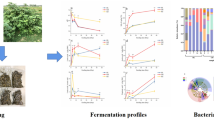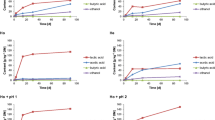Abstract
Woody forage is a new feeding resource used worldwide, and silage is the main long-term storage, mediated by micro-organisms present during their processing. The objectives of our work were to evaluate the fermentation dynamics and to characterize the bacterial community of our typical woody forages. We selected four typical woody forages: paper mulberry (Broussonetia papyrifera), mulberry (Morus alba L.), moringa tree (Moringa oleifera), and Anthocephalus chinensis (Neolamarckia cadamba). The materials were ensiled and sampled after ensiling 1, 3, 5, 7, 15, 30, and 60 days. Our results indicate that woody forages have good forage properties with relatively high crude protein content and low neutral detergent fiber and acid detergent fiber content. However, the water soluble carbohydrate content in paper mulberry was considerably low (18.67 g kg−1), which makes ensiling difficult. The lactic acid and acetic acid contents in each of the four materials were reduced after 3 days of ensiling and increased again after 30 days of ensiling, with the exception of Anthocephalus chinensis. Anthocephalus chinensis and moringa tree were well-preserved after 7 and 60 days of ensiling, respectively, with low pH and ammonia nitrogen content. Cyanobacteria was predominant in moringa tree and Anthocephalus chinensis before ensiling, and Lactobacillus became dominant after 15 days of ensiling. Enterobacter dominated the paper mulberry and mulberry during fermentation process and accelerated their poor silage quality. Therefore, the conformity of bacterial community succession with ensiling parameters guaranteed the final quality of woody forage silages, and this might aid in controlling the manufacturing process.


Similar content being viewed by others
References
Arti P, Pradeep SN (2016) Traditional uses, phytochemistry and pharmacological properties of Neolamarckia cadamba: a review. J Ethnopharmacol 181:118–135
Cai Y, Benno Y, Ogawa M, Ohmomo S, Kumai S, Nakase T (1998) Influence of lactobacillus spp. from an inoculant and of weissella and leuconostoc spp. from forage crops on silage fermentation. Appl Environ Microbiol 64:2982–2987
Cohen ZM, Leibovich H, Vaknin Y, Sagi G, Shabtay A (2016) Effect of feeding lactating cows with ensiled mixture of Moringa oleifera, wheat hay and molasses, on digestibility and efficiency of milk production. Anim Feed Sci Technol 211:75–83
Crush JR, Briggs LR, Sprosen JM, Nichols SN (2008) Effect of irrigation with lake water containing microcystins on microcystin content and growth of ryegrass, clover, rape, and lettuce. Environ Toxicol 23:246–252
Deng XM, Ouyang KX, Zhang Q, Huang H, Chen XY (2011) Research status and development thinking of Neolamarckia cadamba. J Central South Univ For Technol 31:91–95
Dong ZH, Yuan XJ, Wen AY, Desta ST, Shao T (2017) Effects of calcium propionate on the fermentation quality and aerobic stability of alfalfa silage. Asian-Australas J Anim Sci 30:1278–1284
Gan X, Tang HL, Ye DD, Li P, Luo LX, Lin WF (2017) Diversity and dynamic stability of bacterial community in traditional solid-state fermentation of Qishan vinegar. Ann Microbiol 67:703–713
Hejcman M, Hejcmanova P, Pavlu V, Thorhallstottir (2016) Forage quality of leaf fodder from the main woody species in Iceland and its potential use for livestock in the past and present. Grass Forage Sci 71:649–658
Herrmann C, Idler C, Heiermann M (2015) Improving aerobic stability and biogas production of maize silage using silage additives. Bioresour Technol 197:393–403
Huang ZR, Yang J, Lv XJ (2006) The utilization and development of mulberry as animal forage. Grass Forage Sci 32:377–385
Konig W, Lamminen M, Weiss K et al (2017) The effect of additives on the quality of white lupin-wheat silage assessed by fermentation pattern and qPCR quantification of clostridia. Grass Forage Sci 72:757–771
Kraut CJ, Tripathi V, Chen Y, Gatica J, Volchinski V, Sela S, Weinberg Z, Cytryn E (2016) Temporal and spatial assessment of microbial communities in commercial silages from bunker silos. Appl Microbiol Biotechnol 100:6827–6835
Li HX (2010) Influence of ferment Broussonetia papyrifera leaf on nutrients, growing performance, carcass characteristics and meat quality. Dissertation, Guangdong Ocean University
Li LH, Sun YM, Yuan ZH et al (2015) Effect of microalgae supplementation on the silage quality and anaerobic digestion performance of Manyflower silvergrass. Bioresour Technol 189:334–340
Li P, Shen YX, You MH, Zhang Y, Yan JJ, Li DX, Bai SQ (2017) Effect of grape pomace on fermentation quality and aerobic stability of sweet sorghum silage. Anim Sci J 88:1523–1530
McAlliser TA, Feniuk R, Mir Z, Mir P, Selinger LB, Cheng KJ (1998) Inoculants for alfalfa silage: effects on aerobic stability, digestibility and the growth performance of feedlot steers. Livest Prod Sci 53:171–181
McElhiney J, Lawton LA, Leifert C (2001) Investigations into the inhibitory effects of microcystins on plant growth, and the toxicity of plant tissues following exposure. Toxicon 39:1411–1420
McGarvey JA, Franco RB, Palumbo JD, Hnasko R, Stanker L, Mitloehner FM (2013) Bacterial population dynamics during the ensiling of Medicago sativa (alfalfa) and subsequent exposure to air. J Appl Microbiol 114:1661–1670
Ogunade M, Jiang Y, Pech Cervants AA, Kim DH, Oliveira AS, Vyas D, Weinberg ZG, Jeong KC, Adesogan AT (2018) Bacterial diversity and composition of alfalfa silage as analyzed by Illumina Miseq sequencing: effect of Escherichia coli O157:H7 and silage additives. J Dairy Sci 101:2048–2059
Osmari EK, Cecato U, Macedo FA, Souza NE (2011) Nutritional quality indices of milk fat from goats on diets supplemented with different roughages. Small Rumin Res 98:128–132
Silva VP, Pereira OG, Leandro RS, Da Silva TC, Ribeiro KG, Mantovani HC, Santos SA (2016) Effects of lactic acid bacteria with bacteriocinogenic potential on the fermentation profile and chemical composition of alfalfa silage in tropical conditions. J Dairy Sci 99:1895–1902
Tao L, Zhou H, Zhang NF, Si BW, Tu Y, Ma T, Diao QY (2017) Effects of different source additives and wilt conditions on the pH value, aerobic stability, carbohydrate and protein fractions of alfalfa silage. Anim Sci J 88:99–106
Van Soest PJ, Robertsom JB, Lewis BA (1991) Methods for dietary fiber, neutral detergent fiber and nonstarch polysaccharides in relation to animal nutrition. J Dairy Sci 74:3583–3597
Wang J, Wang JQ, Zhou H, Feng T (2009) Effects of addition of previously fermented juice prepared from alfalfa on fermentation quality and protein degradation of alfalfa silage. Anim Feed Sci Technol 151:280–290
Wang J, Chen L, Yuan XJ, Guo G, Li JF, Bai YF, Shao T (2017) Effects of molasses on the fermentation characteristics of mixed silage prepared with rice straw, local vegetable by-products and alfalfa in Southeast China. J Integr Agric 16:664–670
Waroon K, Suradej P, David H, Cai YM (2016) Natural lactic acid bacteria population of tropical grasses and their fermentation factor analysis of silage prepared with cellulase and inoculants. J Dairy Sci 99:9768–9781
Xiong LY (2010) Broussonetia papyrifera feed fermentation and nutritional value of the feed. Dissertation, Guangdong Ocean University
Xue YL, Yin GM, Zhan HP, Bai CS, Sun JJ, Yu Z, Sun QZ (2015) Nutritive value of desert wormwood (Artemisia desertorum Spreng.) silage in mixture with high-moisture maize straw. Grass Forage Sci 72:174–178
Yang C, Cai YM, Tomomi H, Hiroyuki F, Hiroki M (2011) Fermentation characteristics and microorganism composition of total mixed ration silage with local food by-products in different seasons. Anim Sci J 82:259–266
Yang JS, Tan HS, Cai YM (2016) Characteristics of lactic acid bacteria isolates and their effect on silage fermentation of fruit residues. J Dairy Sci 99:5325–5334
Zhang Q, Li X, Zhao M, Yu Z (2015) Lactic bacteria for enhancing the fermentation quality and aerobic stability of Leymus chinensis silage. Grass Forage Sci 71:472–481
Zhang Q, Wu BYL, Nishino N, Wang XG, Yu Z (2016) Fermentation and microbial population dynamics during the ensiling of native grass and subsequent exposure to air. Anim Sci J 87:389–397
Zhang Q, Zhao MM, Wang XG, Yu Z, Na RS (2017) Ensiling alfalfa with whole crop corn improves the silage quality and in vitro digestibility of the silage mixtures. Grassl Sci 63:211–217
Funding
This work was supported by National Key Technology R & D Programme for the 13th Five-year Plan (2017YFD0502102), China; National Key Technology R & D Programme for the 12th Five-year Plan (2011BAD17B02), China; and National Technology Leader “Ten Thousand People Plan” (201502510410040), China.
Author information
Authors and Affiliations
Corresponding author
Ethics declarations
Conflict of interest
The authors declare that they have no conflict of interest.
Additional information
Publisher’s Note
Springer Nature remains neutral with regard to jurisdictional claims in published maps and institutional affiliations.
Electronic supplementary material
Supplement Fig. 1
(JPG 103 kb)
Supplement Fig. 2
(PNG 33 kb)
Supplement Fig. 3
(JPG 57 kb)
Supplement Table 1
(DOCX 27 kb)
Supplement Table 2
(DOCX 18 kb)
Supplement Table 3
(DOCX 23 kb)
Supplement Table 4
(DOCX 22 kb)
Rights and permissions
About this article
Cite this article
Zhang, Y.C., Li, D.X., Wang, X.K. et al. Fermentation dynamics and diversity of bacterial community in four typical woody forages. Ann Microbiol 69, 233–240 (2019). https://doi.org/10.1007/s13213-018-1398-z
Received:
Accepted:
Published:
Issue Date:
DOI: https://doi.org/10.1007/s13213-018-1398-z




